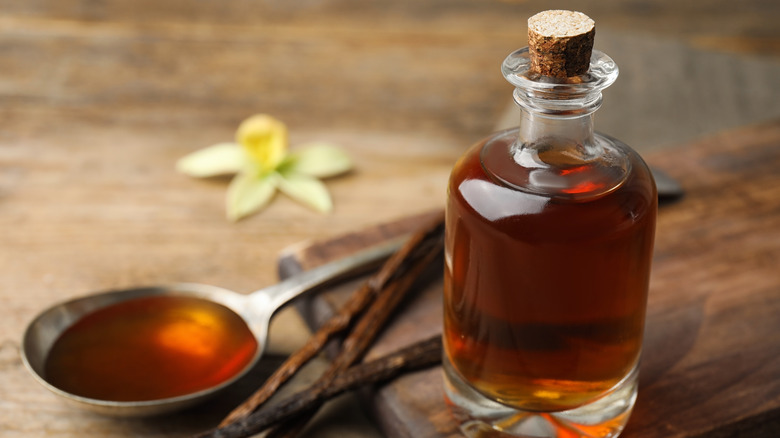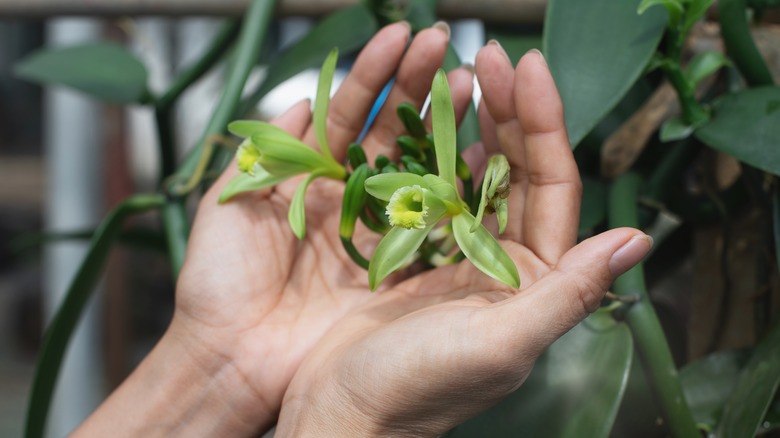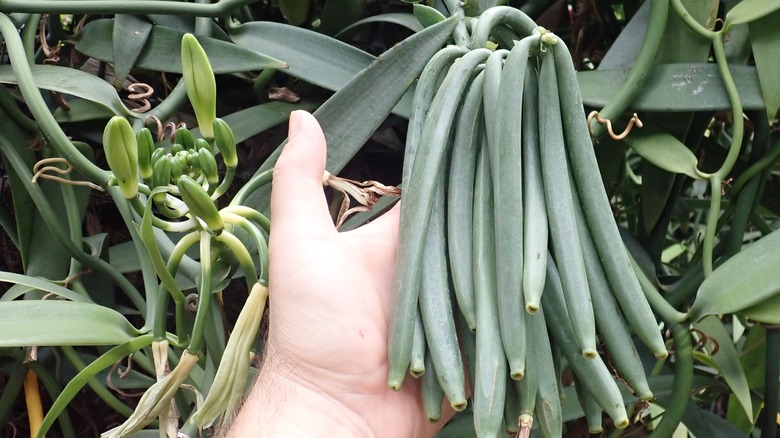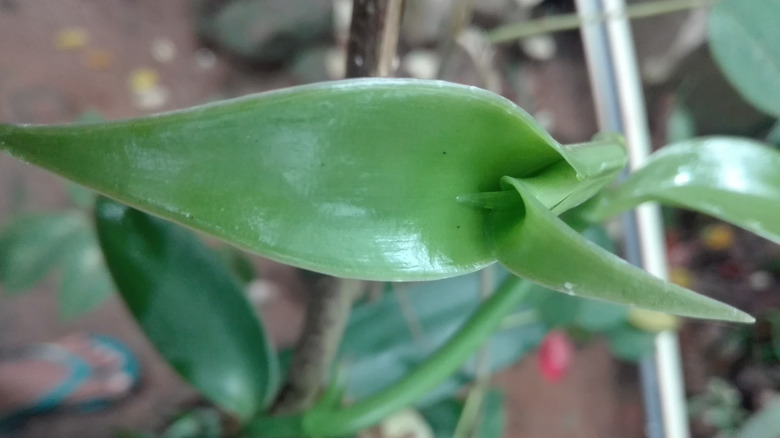3 Types Of Vanilla And What Makes Them Unique
Nearly every kitchen contains a staple ingredient that's far more exotic than most of us realize. The little brown bottle of vanilla extract in your cabinet is derived from the seed pod produced by a tropical orchid, one whose blooms last but a single day and must be hand-pollinated (per Beanilla). Real vanilla extract, which is easy to make at home, is the end result of the laborious process of growing, harvesting, and curing vanilla beans.
And those vanilla beans? There's more than one kind! According to Food Unfolded, vanilla beans originated in Mesoamerica, though they've been planted in hot, humid places around the world. Most of the world's vanilla comes from Madagascar, though Indonesia, Tahiti, Uganda, and Mexico are all big vanilla producers as well. Beanilla explains there are three different kinds of commercially produced vanilla beans, and they all have different qualities and flavors. What are these three kinds of vanilla, and can they be used interchangeably?
Vanilla planifolia
The first kind of vanilla, Vanilla planifolia, is the one most people are familiar with. SloFoodGroup explains that Vanilla planifolia is the ur-vanilla, the variety originally cultivated in Mesoamerica that has now spread to other countries. If you've ever purchased and cooked with Bourbon vanilla beans, you've held Vanilla planifolia in your hands.
The term "Bourbon" applied to vanilla is a history lesson in itself. Cuttings of Vanilla planifolia had spread throughout tropical locations, and French and English horticulturists struggled with getting the vanilla plants to pollinate in order to produce vanilla pods, a process that in vanilla's birthplace had historically been facilitated by a tiny bee native to Mesoamerica. On a small French-held island near Madagascar, however, a 12-year-old enslaved boy developed the tedious practice of hand-pollinating vanilla flowers. Young Edmond Albius made vanilla pod propagation possible in his island home, originally called Ile de Bourbon, according to Food Unfolded. When the practice of hand pollination spread to nearby Madagascar, the vanilla beans were called Bourbon. Bourbon vanilla beans, then, are Vanilla planifolia, prized for their high vanillin content and pure vanilla flavor we love so much.
Vanilla tahitensis
There's a bit of disagreement about the precise origins of the second kind of vanilla, Vanilla tahitensis. SloFoodGroup describes this variety of vanilla as a "very close cousin of Planifolia," and whether it was intentionally crossbred or accidentally hybridized isn't entirely clear. What everyone agrees on is that the variety is native to Tahiti, where it's still grown today. Nielsen Massey, a producer of vanilla and other flavorings, explains that the process of curing Tahitian vanilla beans is a little different than in other vanilla-producing regions. The beans are harvested, rested for a period of five to 10 days, then bathed in water, given a few hours of morning sun each day, then covered in the afternoons. As the beans slowly dry out, they're flattened and smoothed through hand massaging.
Tahitian vanilla doesn't contain as much vanillin as planifolia, and its flavors are more floral and delicate. Nielsen Massey explains that Tahitian vanilla flavors break down more quickly when heated, so they're ideal for cold applications in the kitchen, such as refrigerated or frozen foods. Beanilla adds that Tahitian vanilla is prized for use in perfumes as well.
Vanilla pompona
Vanilla pompona is native to roughly the same area as Vanilla planifolia. Vanillery tells us that while it has and is being grown commercially, larger-scale vanilla producers preferred planifolia to pompona because the former produces larger crops. Pompona is still widely used as a flavoring in Peru and southern Mexico, though sources like Useful Tropical Plants refer to pompona as yielding "an inferior quality of vanilla." Vanillery explains that pompona vanilla isn't necessarily inferior, just better suited to more savory dishes due to its distinctive notes of smoke, cherry, and cinnamon. Pompona beans tend to be larger than either Tahitian or Bourbon (planifolia) beans.
All three kinds of vanilla have different properties and flavors, though all share the core of vanilla-ness you'd expect. Vanilla planifolia is the most common and most versatile. Due to its tendency to break down when heated, Tahitian vanilla is better suited for applications like vanilla buttercream icing. And while it may take a little more work to track down pompona vanilla, it's an ideal choice for adding to savory dishes like baked feta pasta.



